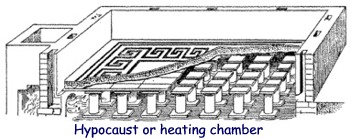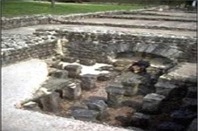|
The
Romans brought underfloor heating to Britain over 2000 years ago.
With their unparalleled construction and road building skills,
they also knew that the most comfortable and efficient way to
heat their homes was by heating the floor. Underfloor heating
- or hypocausts - as they were known then, was a luxury reserved
for the rich and powerful.

The
system worked by passing hot air through ducts built under the
floor by use of brick or concrete columns (they invented concrete
too!). The hot gasses from a fire located beneath the house
were channelled under tiled or paved floors, after which the hot
air would rise through hollow clay boxes (tubulii) built into
the walls before rising further and leaving via chimneys. The
hottest rooms – usually the baths – were often so hot
that bathers needed to wear wooden sandals to protect their feet,
whilst the coolest rooms would be the bedrooms, located at the
farthest point. Heating this way meant a smoke-free room, which
was far superior to the then usual heating method using open charcoal
burners or fires used by the locals.
Underfloor
heating died out after the Romans left as the social structure
fell into disarray, and Britain drifted towards the Dark Ages.
Central heating was not revived again until the start of the industrial
revolution in the 19th Century when the rich merchants and landowners
could afford to fit water filled pipes and cast iron radiators
in their grand mansions. If the Victorians had developed underfloor
heating instead of radiators, then all houses today would have
underfloor heating by default. The modern system of radiators
did not enter the mass housing market until after the second world
war.

|